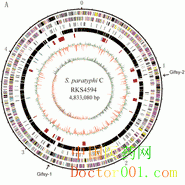|
S. paratyphi C RKS4594基因组图谱 伤寒病致病菌的研究在学术界近百年未有定论。哈尔滨医科大学基因组中心采用比较基因组学方法进行研究,最终证实伤寒病致病细菌是由不同病原体在分别获得有关遗传性状后,各自发展成致伤寒病的特殊病原体,而非由同一祖先进化而来。有关专家认为,这一结论对伤寒病的基础性研究将产生重要影响,近期出版的国际学术期刊《公共科学图书馆·综合》(PLoS ONE)上刊发了该项研究成果。 据哈医大基因组中心主任刘树林教授介绍,课题组采用比较基因组学方法进行研究,具体说来是对丙型副伤寒沙门氏菌RKS4594株测序,将它与已测序沙门氏菌进行比较。RKS4594包含一个4833080bp的染色体和一个55414bp的质粒。研究者们预测了4640个完整编码序列和152个假基因。RKS4594与猪霍乱沙门氏菌有4346个基因相同,但与其他引起人类伤寒病的伤寒沙门氏菌仅有4008个基因相同。在比较了6株伤寒沙门氏菌共有的3691个基因并据此建立了种系进化树之后,研究人员发现,丙型副伤寒沙门氏菌与猪霍乱沙门氏菌共居于进化树之一端,而伤寒沙门氏菌却居于同一棵进化树相反一端的枝头上,这说明丙型副伤寒沙门氏菌和伤寒沙门氏菌来源于不同的直系祖先,二者在致病特性上的相似是趋同进化的结果。 同时,他们认为,丙型副伤寒沙门氏菌在与人类的共进化过程中,很可能遭遇巨大的选择压力,因为丙型副伤寒沙门氏菌和猪霍乱沙门氏菌这两种近缘细菌在一些蛋白质的序列上已发生显著变化,其变化速率远远超过了分子钟在无选择压力下的预期速率。这一发现有助于探讨病原体与人体共进化过程中的彼此互作方式与机制,进而有助于寻找人类控制病原体的新手段。 据刘树林介绍,1881年人类首次从伤寒病人身上分离到伤寒沙门氏菌,并确定其为伤寒病的致病菌。后来又陆续分离到另外一些能引起类似疾病的沙门氏菌,包括甲型副伤寒沙门氏菌和丙型副伤寒沙门氏菌等。这些细菌是来自于共同祖先(即分歧进化的产物)还是各自独立形成的(趋同进化的产物),这个问题的澄清对研究传染病致病因子的起源、进化和控制有着重要的意义。 对这个问题的探讨,欧美科学家始于20世纪上半叶。但由于方法学的限制以及问题本身的复杂性,都没有得出结论。本世纪初,英美科学家先后完成了对伤寒沙门氏菌和甲型副伤寒沙门氏菌的全基因组测序,使本问题的研究有了很大进展。然而,两种细菌的比较还是难以给出确切的答案。出现第三种导致伤寒病的病原菌的测序和与前两种细菌的综合分析就显得十分迫切。 现在,哈医大的科研人员终于为这个多年悬而未决的问题初步找到了答案。他们以翔实的实验数据证明,导致伤寒病的细菌,不是由共同的直接祖先进化而来,而是各自分别获得了有关遗传性状最后发展成侵袭人体并造成伤寒病的特殊病原体。 推荐原始出处: PLoS ONE 4(2): e4510. doi:10.1371/journal.pone.0004510 Salmonella paratyphi C: Genetic Divergence from Salmonella choleraesuis and Pathogenic Convergence with Salmonella typhi Wei-Qiao Liu1,2#, Ye Feng3,4#, Yan Wang2#¤a, Qing-Hua Zou5, Fang Chen5, Ji-Tao Guo5, Yi-Hong Peng5, Yan Jin2¤b, Yong-Guo Li6, Song-Nian Hu3,4, Randal N. Johnston7, Gui-Rong Liu1,2,5*, Shu-Lin Liu1,2,5,6* 1 Genomics Research Center, Harbin Medical University, Harbin, China, 2 Microbiology and Infectious Diseases, University of Calgary, Calgary, Alberta, Canada, 3 JD Watson Institute of Genome Sciences, Zhejiang University, Hangzhou, China, 4 Beijing Institute of Genomics, Chinese Academy of Sciences, Beijing, China, 5 Department of Microbiology, Peking University Health Science Center, Beijing, China, 6 Depatment of Infectious Diseases, First Hospital, Harbin Medical University, Harbin, China, 7 Departments of Biochemistry and Molecular Biology, University of Calgary, Calgary, Alberta, Canada Background Although over 1400 Salmonella serovars cause usually self-limited gastroenteritis in humans, a few, e.g., Salmonella typhi and S. paratyphi C, cause typhoid, a potentially fatal systemic infection. It is not known whether the typhoid agents have evolved from a common ancestor (by divergent processes) or acquired similar pathogenic traits independently (by convergent processes). Comparison of different typhoid agents with non-typhoidal Salmonella lineages will provide excellent models for studies on how similar pathogens might have evolved. Methodologies/Principal Findings We sequenced a strain of S. paratyphi C, RKS4594, and compared it with previously sequenced Salmonella strains. RKS4594 contains a chromosome of 4,833,080 bp and a plasmid of 55,414 bp. We predicted 4,640 intact coding sequences (4,578 in the chromosome and 62 in the plasmid) and 152 pseudogenes (149 in the chromosome and 3 in the plasmid). RKS4594 shares as many as 4346 of the 4,640 genes with a strain of S. choleraesuis, which is primarily a swine pathogen, but only 4008 genes with another human-adapted typhoid agent, S. typhi. Comparison of 3691 genes shared by all six sequenced Salmonella strains placed S. paratyphi C and S. choleraesuis together at one end, and S. typhi at the opposite end, of the phylogenetic tree, demonstrating separate ancestries of the human-adapted typhoid agents. S. paratyphi C seemed to have suffered enormous selection pressures during its adaptation to man as suggested by the differential nucleotide substitutions and different sets of pseudogenes, between S. paratyphi C and S. choleraesuis. Conclusions S. paratyphi C does not share a common ancestor with other human-adapted typhoid agents, supporting the convergent evolution model of the typhoid agents. S. paratyphi C has diverged from a common ancestor with S. choleraesuis by accumulating genomic novelty during adaptation to man. (责任编辑:Doctor001) |





